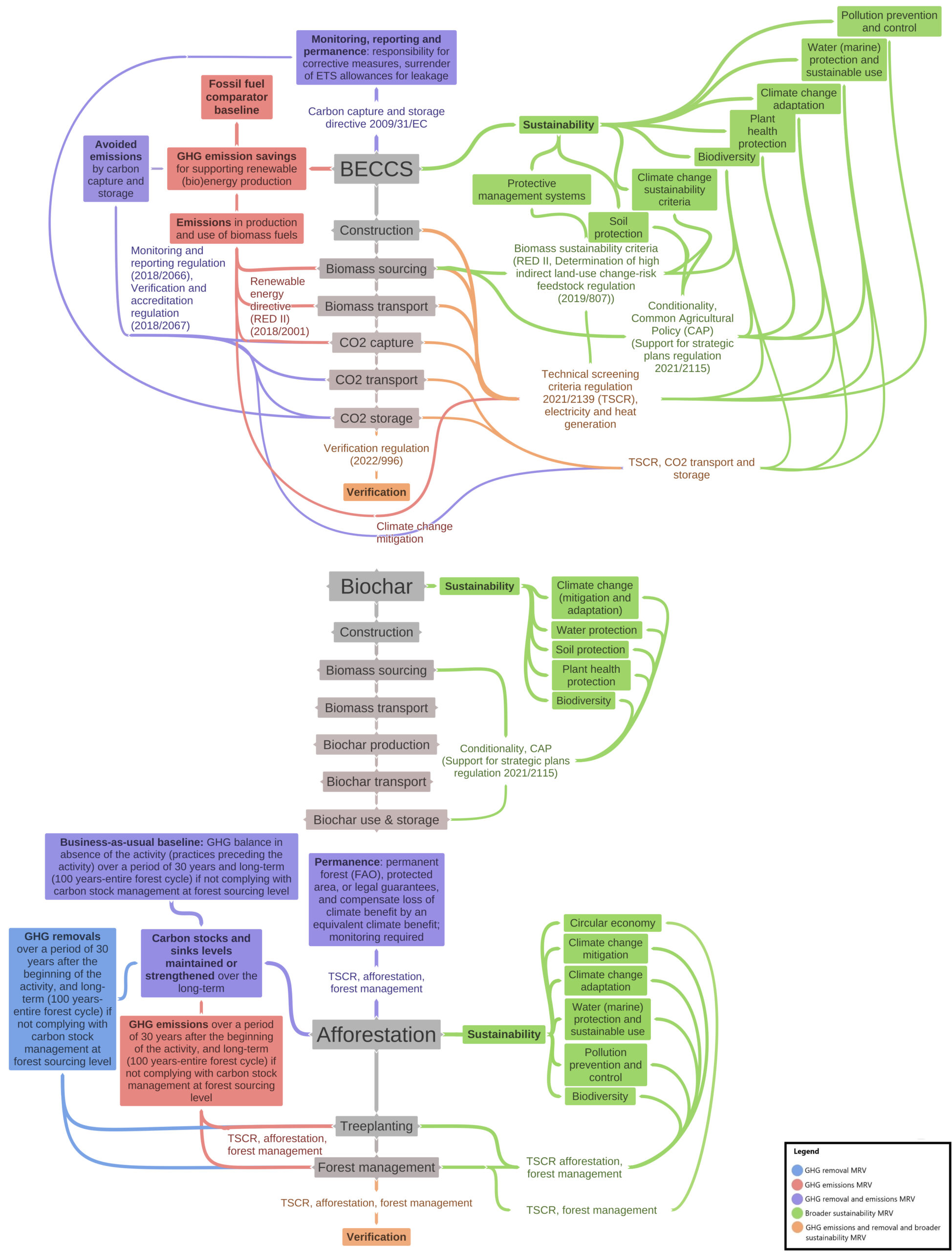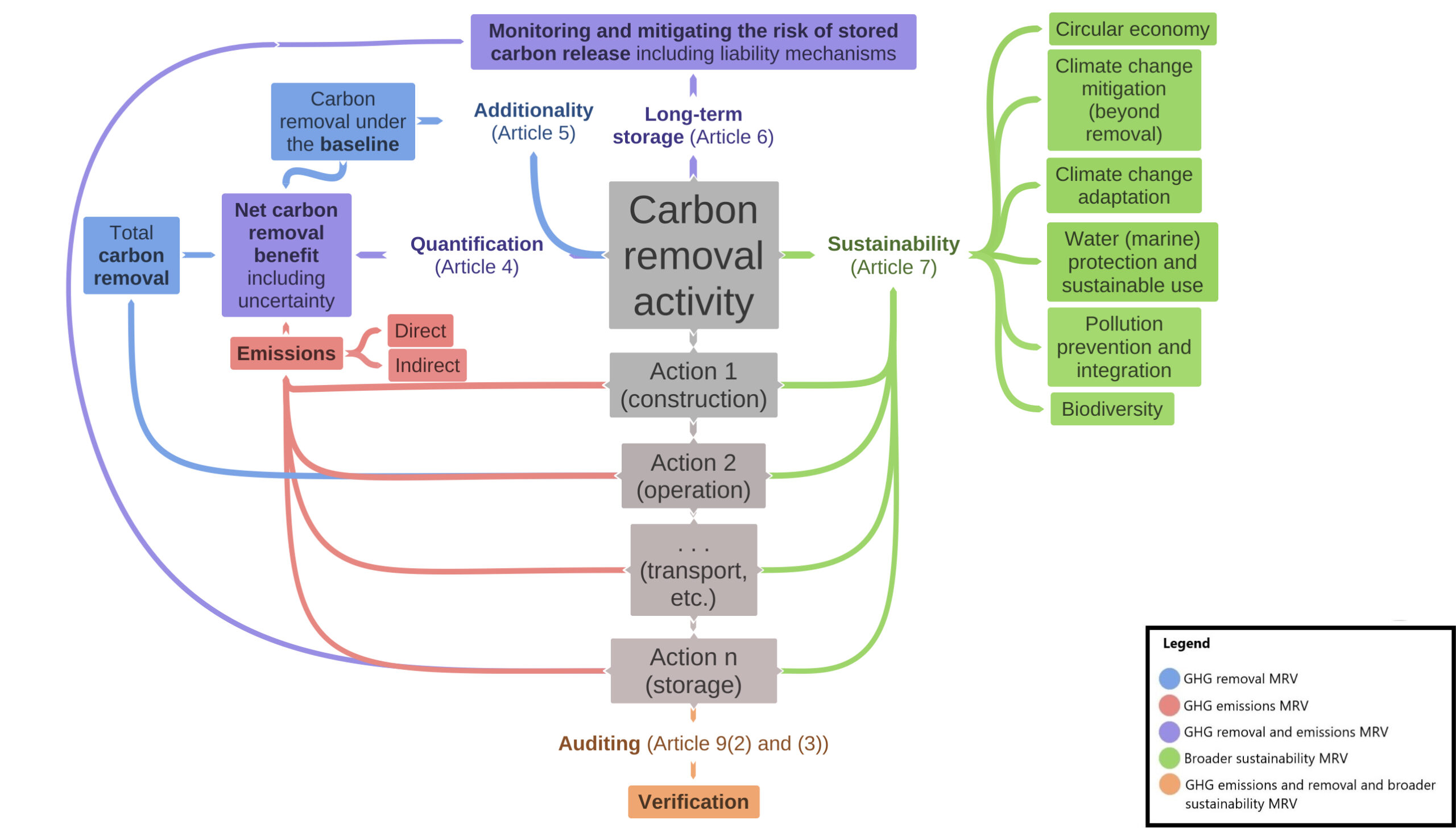By Luka Štrubelj
Context
In alignment with climate goals in the Paris Agreement, deployment of novel Carbon Dioxide Removal (CDR) methods should grow by a factor of 1,300 times on average by 2050 and carbon sinks such as forests and soils should be significantly enhanced too.[1] This must happen alongside ambitious emission reductions.
Considering the availability of many different CDR techniques, as well as methodologies used to quantify and monitor removals, there is a need for lawmakers to establish a level playing field, minimise risks from its deployment, and facilitate deployment of high-quality projects. Differently put, it is crucial to put in place a robust regime for Monitoring, Reporting and Verification (MRV) to prevent greenwashing and ensure that benefits and trade-offs of CDR projects are accurate, and accounted for in a consistent and transparent fashion.
This blog post considers the treatment of CDR MRV under the current EU legislation and under the European Commission’s new proposal for a regulation establishing a Union certification framework for carbon removals (Proposal). Here, the blog post suggests potential improvements to the proposal that builds on an interdisciplinary CO2RE commentary published in One Earth.
CDR MRV in the EU
Under EU law, there is a complex web of regimes that accounts for the effects of CDR projects (Figure 1). The legal coverage varies depending on the specific CDR method employed and its component activities. Greenhouse gas and broader sustainability effects of CDR methods are considerably under-accounted (e.g. biochar). For other methods, these are accounted in a convoluted and overlapping manner (e.g. Bioenergy with Carbon Capture and Storage, BECCS). Furthermore, in terms of accounting climate effects from BECCS, current legislation only accounts for avoided emissions. Project accounting for afforestation, on the other hand, is covered comprehensively by a single legislative instrument (EU Taxonomy) in a clear and concise manner.

Figure 1: CDR MRV as encapsulated in current EU legislation.
European Commission’s Proposal
The European Commission has disclosed how it intends to treat CDR MRV in the future by introducing the proposal for Regulation on Carbon Removal Certification Framework (Proposal). It envisions a voluntary certification framework that will account for four quality criteria (Figure 2):
- Quantification of CDR.
- Additionality (whether the carbon removed by a project or activity is over and above what would have happened in absence of certification).
- Long-term storage.
- Sustainability.
Furthermore, it requires independent verification, sound governance of certification schemes and public accessibility of certification records.

Figure 2: CDR MRV as proposed by the European Commission.
Bringing focus to MRV is crucial for ensuring legitimacy of CDR. The Proposal would account for climate effects of varying CDR projects, bringing comprehensiveness and consistency to MRV legislation akin to the EU Taxonomy’s treatment of afforestation (Figure 2). Moreover, accounting spans broadly and includes sustainability considerations, such as effects on biodiversity and circular economy.
Nevertheless, the Proposal consists of three major shortfalls.
- Crucial notions are left vague and without proper guidance thus depending on operationalisation in methodologies. For example, carbon removal categories are defined in an overlapping and incomprehensive manner ignoring some emerging types of CDR. System boundaries – what constitutes a complete CDR life cycle – are left undefined. Furthermore, CDR is to include emission reductions, risking removal from the atmosphere being confounded with emission avoidance.
- The Proposal does not govern the use of CDR units, consequently making them fungible (interchangeable) on the market, disregarding their fundamental divergences. The equivalence between highly durable, costlier methods relying on geologically stored CO2 and transient carbon removal methods such as carbon farming is particularly worrisome, risking diminished support for the former.
- The Proposal fails to provide direct incentives to support development or deployment of CDR. Simultaneously, a puzzling additionality criterion prevents certification of CDR that is a consequence of statutory requirements and ambiguously limits measures available to increase CDR uptake.
The EU should alter the Proposal to encourage CDR in a sustainable way. We recommend:
- Improving the definitions by excluding emission reductions from the concept of carbon removal, defining CDR categories by the carbon store used, and setting clear system boundaries for already existing CDR methods.
- Introducing limits on use of impermanent CDR methods, especially to limit their fungibility with fossil emissions.
- Indicating and swiftly enacting incentives for CDR deployment to monetise CDR activities and help grow the new industry.
Conclusions
Sound MRV is crucial for developing a CDR industry to deliver legitimate value for the climate and broader sustainability efforts. Currently, EU legislation is inadequately accounting benefits and trade-offs regarding these aspects of CDR. The Proposal attempts to provide a more transparent, accurate, and consistent approach to MRV across a range of CDR methods, which is to be welcomed. Still, there are some deficiencies in how it does this. In moving forward, the proposal needs to introduce better definitions of the most important notions, CDR fungibility regulation and incentives for CDR adoption.
Solid improvements in this manner have already been tabled, via the European Parliament and Council, such as better delineations between different carbon removal categories, clearer assessment boundaries, and overall more detailed guidance. It is now on the European Parliament, European Commission and the Council to make sure these pass the interinstitutional negotiations and get reflected in the updated text of the proposal.





